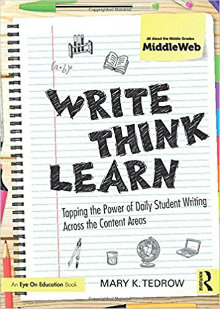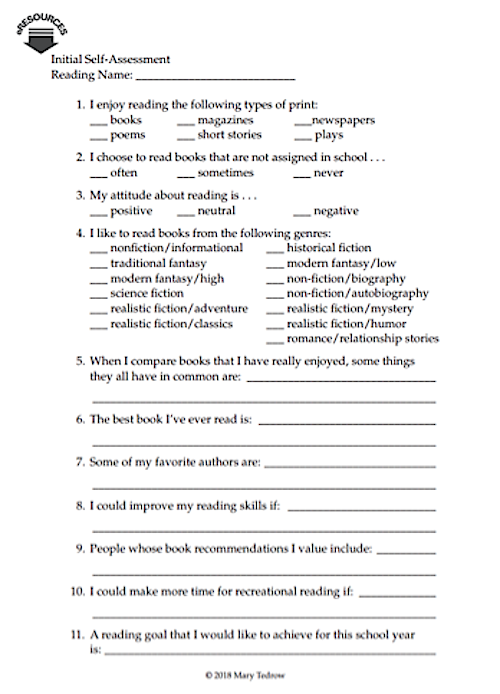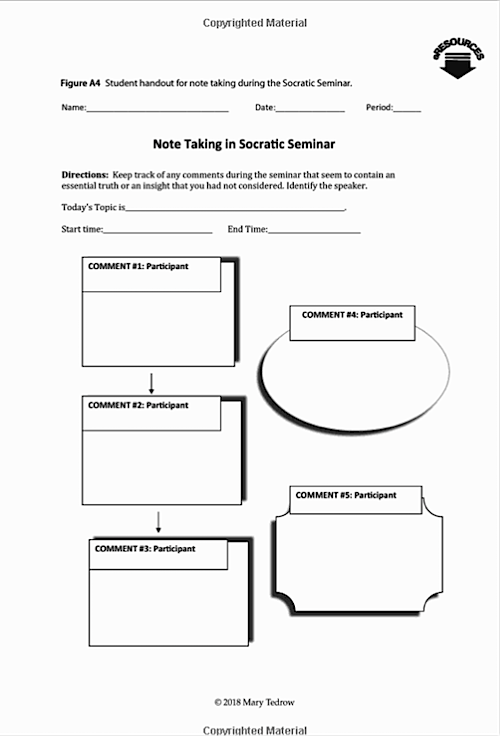Tapping the Power of Daily Student Writing
Write Think Learn: Tapping the Power of Daily Student Writing Across the Content Areas
By Mary K. Tedrow
(Routledge/MiddleWeb, 2018 – Learn more)

Writing well is a powerful life skill.
The ability to write well is a crucial component of being able to communicate to a variety of audiences.
Writing is a valuable tool for communication, sharing of knowledge, and self expression.
All these statements are true, yet the amount of time most students spend writing (in or out of school) is minimal. They need more dedicated instructional time to learn the necessary writing skills, and time to practice those skills so they can gain self confidence as a writer.

The article went on to quote Dr. Troia: “Most teachers are great readers. They’ve been successful in college, maybe even graduate school. But when you ask most teachers about their comfort with writing and their writing experiences, they don’t do very much or feel comfortable with it.”
Write Think Learn as an antidote
Mary K. Tedrow’s recent book, Write Think Learn: Tapping the Power of Daily Student Writing Across the Content Areas, is an extremely valuable resource that can have an impact on these statistics and help address the low incidence of writing across the secondary school curriculum.
I have to admit I love to write and always have. I probably am in the minority. Many adults and students admit that writing has been their least favorite thing to do in school, and many are likely to declare, “I am not a writer.”
For our students to become more successful, we need to discover why we have so many reluctant writers and begin the process of changing this negative mindset. The shift toward regular writing needs to take place in every classroom, not just in English Language Arts, Tedrow believes. “Forming the habit of reflection in writing and goal setting is a lifelong skill you can make available to both your student and yourself.”(p.xi)
Written with teachers in mind
When I began to read this well researched and innovative book, I felt a kinship with the writer. Tedrow is more than an author. Her long career in the classroom has given her a clear understanding of the daily pressures that teachers are experiencing in all subjects. Each of her chapters is written with the busy teacher in mind. In fact, she encourages collaboration with other colleagues as you read the book, building on each other’s ideas, strengths, and questions.
The first chapter explains why and how writing builds self-efficacy and comprehension of content. Each ensuing chapter focuses on other aspects of building a writing challenge for students through purposeful writing prompts, setting and reflecting on goals, thinking critically, writing in content areas, and assessment.
As I read this valuable resource, and noted Tedrow’s close connections with the National Writing Project, it reminded me of a student I had in my classroom several years ago. After completing an Invitational Summer Institute with the Writing Project at Rider University, I had learned how important it was to write each day. I decided to incorporate this mindset into my daily classroom routine.
In spite of some roadblocks in the beginning, all of my students looked forward to the time we spent writing…and just writing. In fact, it made such an impression upon one of my students, that he decided his entire family (including his three- year-old baby sister) had to have Writers Notebooks (which he purchased at the Scholastic Book Fair), and the family had to spend time before dinner writing and sharing their writing.
Powerful! He understood something important about building our power through writing – at nine years old!
Let Daybooks help
Chapter Two introduces the concept of writing in Daybooks. Ideas that resonate with me:
- Write with your students. Enjoy writing.
- Make time each day for writing and stick to it.
- Find a type of notebook/Daybook that “speaks to you” and listen to it.
- Number the blank pages (reduces the temptation to rip out pages and use them in other classes).
- Protect student voice: “This book is for you, not for a grade.”
- Create a mission statement based on personal goals for the Daybook.
- Build the writing habit for twenty-one days and it will stick.
- Write with your students! Enjoy writing.
Of particular interest and definite importance is the chapter that focuses on reflection and goal setting with an emphasis on inquiry. All of Tedrow’s work is founded upon and supports current research in education. She shares ideas on how students can effectively use reflection and goal setting in their Daybooks through prompts such as thinking about who they are as readers and how their journey as an early reader began and why it’s important to read (and write) in our areas of interest.
Throughout the book you will find that the activities challenge the students to become more proficient and deeper thinkers. Instead of writing “to the prompt,” they are encouraged to think about what the prompt asks them as thinkers. How does it change their present thinking?

For school districts that require an assessment/grade for activities such as writing in the Daybook, there are several rubrics available that you can use or adapt to your own classroom. Although the daybook strategy would be better suited for the upper grades, I found many excellent resources that I could apply in upper elementary school classrooms such as the Socratic Seminar (see example below).

Now retired from teaching fourth graders, Linda Biondi is supervising preservice and student teachers at The College of New Jersey this year. Over the summer she co-facilitated a weeklong writing institute in conjunction with the National Writing Project at Rider University. She volunteers for two service organizations: Homefront and Dress for Success of Central New Jersey – both have a mission to end poverty and homelessness. The mission of Dress for Success is to empower women to achieve through economic independence.


































